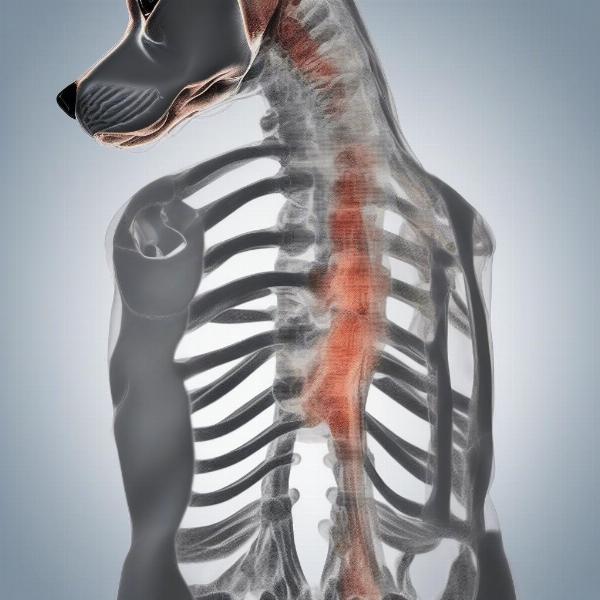Discovering a lump on your dog’s rib cage can be alarming. While not all lumps are cancerous, it’s crucial to understand the potential causes, diagnostic procedures, and treatment options. This article will guide you through everything you need to know about lumps on a dog’s rib cage, providing you with the knowledge to make informed decisions regarding your furry friend’s health.
Understanding Lumps on a Dog’s Rib Cage
Lumps on a dog’s rib cage can vary in size, shape, and texture. They can be firm or soft, movable or attached to underlying tissues. The location of the lump can also offer clues to its potential cause. While some lumps are benign, like lipomas (fatty tumors), others can be malignant (cancerous) or indicate underlying infections or injuries. The breed, age, and overall health of your dog can also influence the nature of the lump. Therefore, any new lump or bump should be examined by a veterinarian.
Common Causes of Lumps on a Dog’s Rib Cage
Several factors can contribute to lump formation on a dog’s rib cage. These include:
- Lipomas: These are benign fatty tumors that are common in older dogs, especially those who are overweight. They are typically soft, movable, and don’t cause pain.
- Cysts: These are fluid-filled sacs that can develop under the skin. They are usually soft and can be benign or malignant.
- Abscesses: These are pockets of pus caused by bacterial infections. They are often painful, warm to the touch, and may be accompanied by other symptoms like fever and lethargy.
- Tumors: Both benign and malignant tumors can develop on a dog’s rib cage. These can include mast cell tumors, soft tissue sarcomas, and osteosarcomas (bone cancer).
- Traumatic Injuries: Blows or other injuries to the rib cage can cause swelling and lump formation.
Diagnosing a Lump on Your Dog’s Rib Cage
If you discover a lump on your dog’s rib cage, the first step is to schedule a veterinary appointment. The vet will perform a physical examination and may recommend further diagnostic tests to determine the nature of the lump. These tests can include:
- Fine-needle aspiration (FNA): A small needle is inserted into the lump to collect cells for microscopic examination.
- Biopsy: A small tissue sample is removed from the lump and analyzed in a laboratory.
- Imaging tests: X-rays, ultrasound, or CT scans can provide detailed images of the lump and surrounding tissues.
“Early diagnosis is key to successful treatment,” says Dr. Emily Carter, DVM, a veterinary oncologist with over 15 years of experience. “The sooner we identify the cause of a lump, the better the chances of a positive outcome.”
Treatment Options for Lumps on a Dog’s Rib Cage
Treatment for a lump on a dog’s rib cage depends on the underlying cause. Options include:
- Surgical removal: This is the most common treatment for most types of lumps, especially if they are cancerous or causing discomfort.
- Draining: Abscesses may be treated by draining the pus and administering antibiotics.
- Medication: Some types of tumors may be treated with chemotherapy or radiation therapy.
- Monitoring: Benign lipomas that are not causing problems may simply be monitored for changes in size or appearance.
 X-ray of a dog's rib cage
X-ray of a dog's rib cage
Conclusion
Finding a lump on your dog’s rib cage can be concerning, but it’s important to remain calm and seek veterinary attention. By working closely with your veterinarian and following their recommendations, you can ensure your furry friend receives the appropriate diagnosis and treatment. Early detection and intervention are often crucial for a positive prognosis.
FAQ
- Q: Are all lumps on a dog’s rib cage cancerous? A: No, not all lumps are cancerous. Many lumps are benign, such as lipomas (fatty tumors).
- Q: Should I be worried if I find a small lump on my dog? A: Any new lump should be checked by a veterinarian, regardless of its size.
- Q: How is a lump on a dog’s rib cage diagnosed? A: Veterinarians use various diagnostic tools, including fine-needle aspiration, biopsy, and imaging tests like X-rays and ultrasound.
- Q: What are the treatment options for a cancerous lump? A: Treatment options for cancerous lumps may include surgery, chemotherapy, and radiation therapy.
- Q: How can I prevent lumps from developing on my dog’s rib cage? A: Maintaining a healthy weight and providing regular exercise can help reduce the risk of some types of lumps. Regular veterinary checkups are also important for early detection.
- Q: What should I do if the lump is growing rapidly? A: Contact your veterinarian immediately if you notice any changes in the lump’s size, shape, or appearance.
- Q: Can injuries cause lumps on a dog’s rib cage? A: Yes, trauma to the area can cause swelling and lump formation.
“Regular checkups are crucial for catching potential issues early on,” adds Dr. Carter. “Don’t hesitate to contact your vet if you have any concerns about your dog’s health.”
ILM Dog is your trusted resource for all things canine. We offer expert advice and resources on dog breeds, health, training, nutrition, grooming, and much more. Whether you’re a new dog owner or a seasoned expert, ILM Dog is here to support you every step of the way. For more information, please contact us at [email protected] or call us at +44 20-3965-8624. Visit ILM Dog today for all your dog care needs.